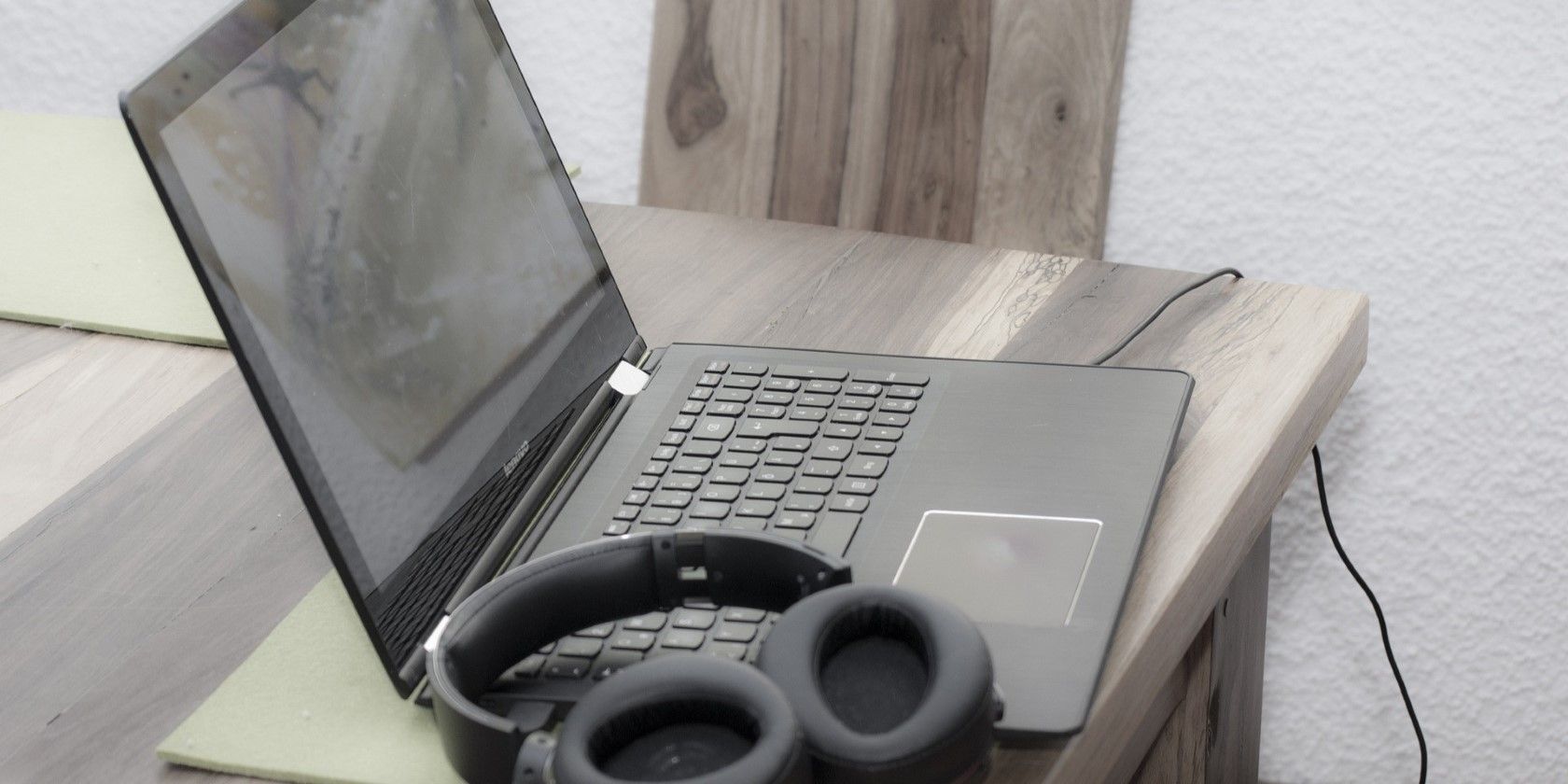
Riding on Innovation: Discover How Lenovo Is Boosting Its Legion #7000K Towers with Locally Developed Processor Technology in China

Ultimate Guide to Assembling the Perfect Gaming Machine : Ideas for Every Budget Under & Above $1,000
If you want a computer that meets your exact needs and budget, you need to put it together yourself. When you build a gaming PC, you get total control of the parts, choosing the exact make and model of motherboard, a case with the look you like and even the layout of RGB (or non-RGB fans). You could save time by purchasing one of thebest pre-built gaming PCs , but you’ll give up control and spend more.
By constructing your own PC from components, you will likely save hundreds of dollars over the cost of buying a prebuilt system. For example, right now, getting a desktop with specs similar to those in our best $1,000 PC build will cost you$1,439 or more at Best Buy .
To help you assemble the best PC build for gaming or productivity that you can get, we’ve created recommended parts lists for every budget: from a super-cheap sub-$500 system to an affordable sub-$1,000 build to a $4,000+ dream machine for those with deep pockets.
Picking and Pricing the Best PC Builds
Why you can trust Tom’s Hardware Our expert reviewers spend hours testing and comparing products and services so you can choose the best for you.Find out more about how we test .
Note that our best PC build recommendations are based on our component expertise, market research and testing we’ve done of the key components in each build, namely the CPU, GPU and SSD. However, because we are trying to hit price points and frequently changing these lists (as prices change), we have not tested all of the parts in each build together and some of the less performance-centric parts such as the case, motherboard and PSU may be ones that we have not reviewed.
We are also going to recommend GPUs rather than specific makes and models of graphics cards. For example, we’d recommend an RTX 4070 Ti and link to a list of available cards rather than, for example, theZotac RTX 4070 Ti . Given frequent price and stock changes in the space, you should get whichever third or first-party card is available with the GPU you want for the best price at the time you read this.
Also note that we don’t include the cost of an operating system, because you can getWindows for Free or Cheap . Nor do we include the price of peripherals such as thebest gaming monitors ,best gaming keyboards orbest gaming mouse . And if you’ve never made a computer before, see our article onhow to build a PC .
Best $500 PC Build for Gaming
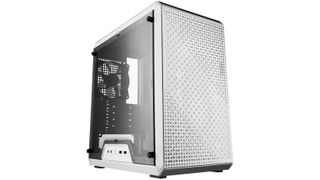
(Image credit: Newegg)
Swipe to scroll horizontally
| Component Type | Model | Price (at Pub Time in USD) |
|---|---|---|
| CPU | Intel Core i3-14100F | $124 |
| Motherboard | ASRock B760M-HDV | $94 |
| GPU | Intel Arc A380 | $119 |
| RAM | Silicon Power Value Gaming DDR4 RAM 16GB (8GBx2) 3200MHz | $28 |
| Storage | Crucial P3 Plus (1TB) | $66 |
| Case | Cooler Master MasterBox Q300L | $38 |
| PSU | Thermaltake Smart Series 500W | $39 |
| Cooler | N/A, comes with CPU | Row 7 - Cell 2 |
| Total | Row 8 - Cell 1 | $508 |
For around $500, you can build a PC that has a discrete graphics card. You won’t get the fastest GPU around, but you will be able to play games at 1080p with modest settings. That’s a big improvement over relying on integrated graphics.
For the graphics card in this system, we’re going withIntel’s Arc A380 . We didn’t love the card at launch, but it’s readily available atAmazon for $119 and has been for a long time. Besides that, it’s faster than AMD’s competing RX 6400, comes with more VRAM, and most importantly it has full video encoding/decoding acceleration — including AV1 support for the future.
The card averaged 54.7 fps in our benchmarks at 1080p medium, though updated drivers may have improved things another 5–10 percent. If you want something a little faster and can expand your budget by just a few dollars, your best bet is thisRX 6500 XT card , which goes foraround $139 and can take you up to 65.8 fps in 1080p medium.
For our CPU, we’re going with Intel’s Core i3-14100F which is just over $100 but delivers plenty of pep for the price. This CPU has four cores, all of them performance cores, and a solid boost clock of 4.7 GHz. It comes with a cooler in the box so there’s no need for a third-party one. We found that the 13100F was about on par with AMD’s Ryzen 5 5600, which costs about $30 more.
To work with our 14100F, we need an Intel 700-series motherboard. Finding the right balance of features and pricing is critical, and you need to be careful that you pick a board that uses the correct type of memory. DDR5 boards can sometimes be $10 cheaper but then the memory can cost $20 more. The best overall value right now is theGigabyte B760M DS3H DDR4 , a microATX board that uses DDR4 RAM and comes with two M.2 PCIe 4.0 slots for SSDs, plus four memory slots, offering decent options for future upgrades.
At this price, the motherboard has one big trade-off, which is that you don’t get built-in Wi-Fi. So, if you need wireless, you’ll need to buy your own USB or PCIe Wi-Fi dongle, which usually costs between $25 and $40. You may already have one or maybe you’ll be using Ethernet. Alternatively, you could look for a similar board that includes Wi-Fi, but the least expensive DDR4 board we could find is thisMSI Pro B760-P WiFi for $149 — a $50 bump for that one feature.
We chose theSilicon Power UD90 as a very affordable PCIe 4.0 SSD that delivers up to 5,000 MB/s for sequential reads and 4,800 MB/s for sequential writes. The UD90 uses TLC NAND, which means performance won’t collapse as the drive fills up — a common concern with SSDs that uses cheaper QLC NAND. When we tested the 1TB model a couple of years back, we declared it the new value champion for SSDs. There are cheaper drives, but nothing can match the overall performance without increasing the price. It doesn’t have a DRAM cache, so if you want that feature you’ll need to buy a more expensive drive (see the builds below for other options).
We selected 16GB of DDR4 PC-3200 RAM in a 2x8GB configuration for our memory. Again, choosing RAM that works with your motherboard is critical. The Silicon Power Value RAM we chose isn’t the flashiest, but it’s inexpensive and memory has become a commodity item. Whatever you do, don’t build or buy agaming PC with less than 16GB of RAM .
Our case is the Cooler Master MasterBox Q300L. Available in black or white, the chassis has solid build quality for the price, including built-in dust filters, support for up to a 240mm AIO cooler on the top, and plenty of mesh to allow airflow in. It even has a modular I/O panel you can place in six different locations. One small trade-off is that its clear side panel is acrylic rather than tempered glass.
Finally, we need something to power the whole system, and this is an area where we opted to compromise in pursuit of the $500 price point. The $40 500W PSU should be fine for this basic build, which will likely peak at around 200W of power use, but the Thermaltake Smart series isn’t exactly highly regarded, and the listing mentions Haswell support (circa 2014) and it only has 80 Plus certification, which are clear drawbacks. If you want a quality PSU, check out theThermaltake Toughpower GX2 600W that costs $20 more. It’s an 80 Plus Gold certified PSU, from a reputable brand, albeit overkill for a build like this.
Best $800 PC Build for Gaming
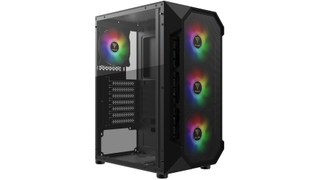
(Image credit: Amazon)
Swipe to scroll horizontally
| Component Type | Model | Price (at Pub Time in USD) |
|---|---|---|
| CPU | Intel Core i5-14400F | $199 |
| Motherboard | ASRock B760M-HDV | $89 |
| GPU | Nvidia RTX 4060 | $293 |
| RAM | TeamGroup T-Force Zeus DDR4 32GB (2x16GB) | $50 |
| Storage | Silicon Power UD90 (1TB) | $64 |
| Case | Gamdias Aura GC1 | $53 |
| PSU | Thermaltake Smart 700W | $54 |
| Cooler | N/A, comes with CPU | Row 7 - Cell 2 |
| Total: | Row 8 - Cell 1 | $802 |
If you can stretch your budget up from $500 to $800, you can enter a whole new world of gaming performance and productivity that will be good enough for some serious 1080p gaming (without ray tracing). Here we’re stepping up from a Core i3 to the Core i5-14400F, which has 6 performance cores, 4 efficiency cores and 16 total threads, along with a boost clock of 4.7 GHz.
To be fair, the 14400F is not the fastest gaming CPU in its price range as that honor belongs to AMD’s Ryzen 7 5700X3D and its generous V-Cache. However, AMD’s chip requires a slightly-more-expensive motherboard and needs a third-party cooler while Intel’s chip comes with a stock air cooler in the box. As you can see in the chart below, the 14400F (listed as the 14400, but the F model is just the SKU without integrated graphics), was behind some competitors but still turned in solid performance.
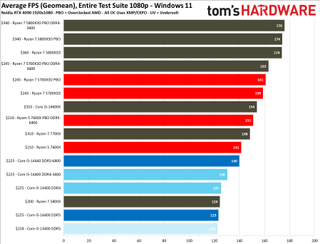
(Image credit: Tom’s Hardware)
To go with this Intel processor, we’re using an ASRock B760M-HDV motherboard because it supports 14th Gen CPUs without a BIOS update. It’s a DDR4 board so we can save money by using DDR4 memory. It also features two M.2 slots for SSDs, with one of them supporting PCIe 4.0 drives.
Our graphics card at this price point is the Nvidia RTX 4060, which comes in just under $300. The 4060 has strong performance at 1080p, ultra settings, having averaged 84.9 fps on our suite of tests. It ranks just above the RTX 2080 and below the Raden RX 6700 on ourGPU benchmarks hierarchy .
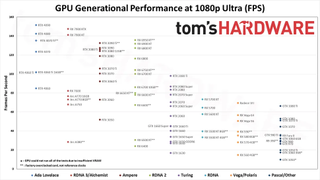
(Image credit: Tom’s Hardware)
The card can also do some ray tracing as it averaged 41.7 fps on 1080p ultra with ray tracing enabled. Forget about playing in 2K with ray tracing as that only gave us 25.8 fps.
For our storage, we’re going with the 1TB Silicon Power UD90. This budget-oriented PCIe 4.0 SSD can’t beat the top-of-the-line drives like the Samsung 990 Pro orWD Black SN850X, but it has really strong performance for the money, promising sequential reads and writes of 4,800 and 4,200 MBps.
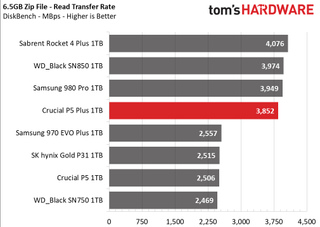
(Image credit: Tom’s Hardware)
We’re going with 32GB of TeamGroup T-Force Zeus DDR4 RAM and we’re stepping up to a 700W version of theThermaltake Smart power supply so we can support our higher wattage CPU and GPU.
Our case is the Gamdias Aura GC1, a full-size ATX case that comes with four ARGB fans. The GC1 has a mesh front for optimal airflow and plenty of room for expansion.
Best $1,000 PC Build for Gaming

(Image credit: Newegg)
Swipe to scroll horizontally
| Component Type | Model | Price (at Pub Time in USD) |
|---|---|---|
| CPU | AMD Ryzen 7 5700X3d | $192 |
| Motherboard | Gigabyte B550 UD AC | $109 |
| GPU | RTX 4060 Ti | $364 |
| RAM | Crucial RAM 32GB Kit (2x16GB) DDR4 3200 | $68 |
| Storage | WD Blue SN580 (2TB) | $119 |
| Case | Phanteks XT Pro | $49 |
| PSU | Corsair CX750M | $89 |
| Cooler | ID-Cooling FrostFlow 280mm | $59 |
| Total: | Row 8 - Cell 1 | $1,049 |
If you can stretch your budget up to around $1,000, you can build a PC with the ability to play games really well at 1080p and competently at 1440p. The best GPU option in this price range right now is theNvidia RTX 4060 Ti , which goes for as little as $374. While the Radeon RX 6750 XT, which has 12GB of VRAM to the 4060 Ti’s 8GB, is in the same price range, Nvidia’s GPU is much better for ray tracing.
In our 8-game rasterization test suite at 1080p ultra settings, the RTX 4060 Ti offered an impressive frame rate of 101.7 fps while delivering a still-strong 75.5 fps at 1440p with ultra settings. At this price point, don’t expect to do much ray tracing, however. The card managed a very-playable 52.8 fps at 1080p and a usable 33.5 fps at 1440p.
Our recommended CPU for this build is theAMD Ryzen 7 5700X3D , which is one of thebest gaming CPUs you can get, particularly for the price. This 8-core, 16-thread CPU has 96MB of L3 cache, which makes it great for 1080p gaming. On our tests, it edged out more-expensive competitors like the Ryzen 5 7600X and the Core i5-14400.
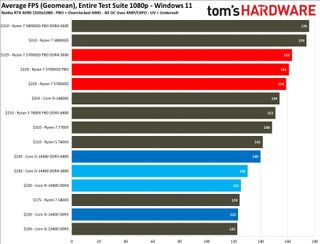
(Image credit: Newegg)
To support our Ryzen 7 57003XD, we’re using a Gigabyte B550 UD AC motherboard. This board has built-in Wi-Fi 6 and it also has Q-Flash, which allows you toupdate the BIOS , before you install the CPU. This may be necessary as the 5700X3D just came out a few months ago.
The Ryzen 7 5700X3D doesn’t come with a stock cooler so we’re adding an inexpensive, 240mm AIO cooler to the mix.
We’re sticking with 32GB of DDR4-PC3200 RAM here. There’s no real need to go faster or increase the capacity at this price point. Using DDR4 saves us money over DDR5.
For storage, we’re stepping up to a faster, higher-capacity SSD: the 2TB version of WD Black SN580. This PCIe 4.0 drive promises sequential read and write speeds of 4,150 MBps, along with random read / write IOPS of 600K and 750K respectively. It’s not the fastest drive on the market, but it gets the job done.

(Image credit: Tom’s Hardware)
We’re going with thePhanteks XT Pro as our case, because it has a quality, mesh design, room for up to a 360mm AIO up top and the ability to support back-connecting motherboards, should you get one in the future. For $20, you can get thePhanteks XT Pro Ultra , which comes with four ARGB fans.
Finally, we’ve stepped up to a 750-watt power supply and we’re going with Corsair CX750M, which is 80+ Bronze certified and semi-modular. You can get a modular PSU or one that’s 80+ Gold certified for a bit more, but that’s money you don’t need to spend at this price point.
Best $1,500 PC Build for Gaming
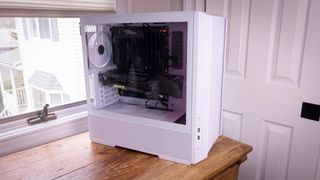
(Image credit: Tom’s Hardware)
Swipe to scroll horizontally
| Component Type | Model | Price (at Pub Time in USD) |
|---|---|---|
| CPU | Intel Core i5-14600KF | $292 |
| Motherboard | Gigabyte Z790 Gaming X AX | $199 |
| GPU | Nvidia RTX 4070 | $529 |
| RAM | Crucial Pro RAM 32GB (2x16GB) DDR5 | $103 |
| Storage | WD Black SN850X (2TB) | $164 |
| Case | Lian Li Lancool 216RX | $99 |
| PSU | Corsair CX750M | $89 |
| Cooler | ID-Cooling FrostFlow 280mm | $59 |
| Total: | Row 8 - Cell 1 | $1,534 |
As we step up to a build that should be brilliant at 1080p gaming, really strong for 1440p gaming and capable of running ray tracing games well, we’re looking at around a $1,500 budget, depending on the current prices on graphics cards. We recommend going with an RTX 4070 at this price point.
At press time, RTX 4070 cards selling for as little as $5. In ourGPU benchmarks hierarchy, the 4070 beats the RTX 3080 (10GB) and comes in just a step behind the 3080 (12GB) at non-ray tracing 1080p gaming. On our suite of 8 games, at 1080p ultra settings, the 4070 managed 123.6 fps. At 1440p resolution, it offered a smooth 98.6 fps and, even at 4K, it provided a very-playable 67.2 fps.
With ray tracing enabled, the RTX 4070 delivers 69.4 fps at 1080 ultra and a playable 45.2 fps at 1440p. In some titles, the numbers are much higher. For example, in Spider-Man: Miles Morales at 1440p, the card returned an average frame rate of 69 fps.
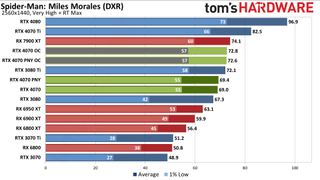
(Image credit: Tom’s Hardware)
We’re also upgrading the CPU toIntel’s Core i5-14600KF , an overclockable processor that has 6 performance cores, 8 efficiency cores, 20 threads and a boost clock of 5.3 GHz. That’s before you attempt to overclock it.
We’re going with the Gigabyte Z790 Gaming X AX motherboard, which allows overclocking with a 16+2+1 phases digital VRM design. It also comes with built-in WI-FI 6E, USB 3.2 Gen 2x2 (20 Gbps), 2.5 GbE LAN and Q-Flash Plus BIOS updating ability.
Though Intel 14th Gen CPUs can use DDR4 or DDR5 RAM, this motherboard utilizes DDR5 RAM. So we’re going with an affordable 32GB kit from Crucial with a top speed of 5600 MT/s.
We’re going with one of the best PCIe 4.0 SSDs you can buy, WD’s Black SN850X at 2TB. In our tests, it was neck and neck with the other top drives, including the SK hynix Platinum P41 and the Samsung 990 Pro.
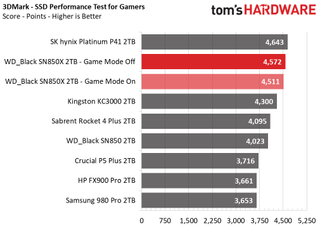
(Image credit: Tom’s Hardware)
Our case for this build is the $99Lian Li Lancool 216 . When we reviewed the Lancool 216, we praised its included dual RGB 160mm front and single 140mm exhaust fans, excellent cable management and attractive looks. There’s also plenty of room for a top-mounted radiator that’s up to 360mm.
Our power supply is a 750-watt Corsair CX750M. This 80 Plus Gold certified PSU packs enough power to support our GPU with plenty of juice to spare. However, it’s not fully modular, with some of the wires being built-in.
Best $2000 PC Build for Gaming
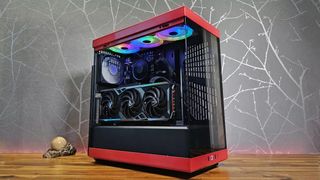
(Image credit: Tom’s Hardware)
Swipe to scroll horizontally
| Component Type | Model | Price (at Pub Time in USD) |
|---|---|---|
| CPU | AMD Ryzen 7 7800X3d | $393 |
| Motherboard | Gigabyte B650M Aorus Elite AX | $159 |
| GPU | Nvidia RTX 4070 Ti Super | $789 |
| RAM | G.Skill Trident Z5 RGB Series 32GB (2 x 16GB) DDR5 6000 | $112 |
| Storage | WD Black SN850X (2TB) | $164 |
| Case | Hyte Y40 | $123 |
| PSU | Corsair RM750e | $99 |
| Cooler | Iceberg Thermal IceFLOE Oasis 360mm | $89 |
| Total: | Row 8 - Cell 1 | $1,928 |
At a current price of $1,906, our high-end gaming PC build should provide enough performance to play games at 1440p ultra settings with strong frame rates, and 4K ultra with playable frame rates. The system gets its GPU muscle from an Nvidia RTX 4070 Ti Super which is currently available for $799. The card is backed byAMD’s Ryzen 7 7800X3D , which is the best CPU for gaming if you’re able to pay its $339 asking price.
In our tests, the RTX 4070 Ti Super delivered a really-smooth 102.9 fps on our test suite of games at 2K settings without ray tracing. It even managed to hit 73.7 fps at 2K with ray tracing enabled.
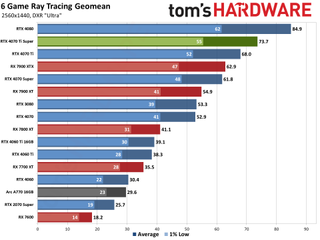
(Image credit: Tom’s Hardware)
The AMD Ryzen 7 7800X3D offers a superior experience thanks to its 104MB of 3D cache, along with its 8 cores, 16 threads and 5-GHz boost clock. Yes, AMD makes the Ryzen 9 7950X3D which is even faster overall, but it costs a lot more money and either ties or comes in behind the 7800X3D on many gaming tests.
On our suite ofWindows 11 tests, running at 1080p with an RTX 4090 card, the 7800X3D averaged 224 fps, putting it slightly ahead of the Ryzen 9 7950X3D (222 fps) and way ahead of Intel’s top-ranked Core i9-13900K (200 fps).
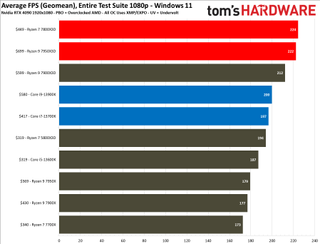
(Image credit: Tom’s Hardware)
To cool the CPU, we’re using an Iceberg Thermal IceFLOE Oasis 360. When wetested the IceFLOE , we were impressed with its low noise output and fantastic cooling output that allowed it to disperse up to 237 watts of heat. It has attractive RGB and you get all of that for a measly $89.
Our motherboard is Gigabyte B650M Aorus Elite AX which is one of the more affordable AM5 motherboards you can buy but it still packs in Wi-Fi 6E radio. AMD Zen 7000 chips require DDR5 RAM so we’re going with 32GB of G.Skill Trident Z5. The Trident Z5 kit tops our list ofbest RAM , thanks to its tight-timings, fast performance and overclocking potential. In our tests, the Z5 also had the lowest memory latency of its competitors.
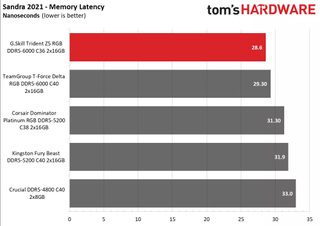
(Image credit: Future)
For the SSD, we’re sticking with the WD Black SN850X at 2TB. You really can’t do much better without spending a lot more money on a PCIe 5 drive or a 4TB capacity.
Our case is Hyte Y40, which is a great showcase for our components. It has beautiful wraparound glass that extends from the front to the left side. The case is available in three colors but we really like it in red.
To power all these high-end components, we’re using a Corsair RM750e PSU which is 80+ Gold certified and fully modular.
Best $4000+ PC Build for Gaming

(Image credit: Tom’s Hardware)
Swipe to scroll horizontally
| Component Type | Model | Price (at Pub Time in USD) |
|---|---|---|
| CPU | AMD Ryzen 9 7900X3D | $591 |
| Motherboard | Asus ROG Strix X670E-E | $439 |
| GPU | Nvidia RTX 4090 | $1,764 |
| RAM | G.Skill Trident Z5 RGB DDR5 (2 x 16GB) DDR5 6400, 2 kits | $218 |
| Storage | Samsung 990 Pro (4TB) | $299 |
| Case | Fractal Design North XL | $189 |
| PSU | Corsair RM1000e | $179 |
| Cooler | Cooler Master MasterLiquid PL360 FLUX | $129 |
| Total: | Row 8 - Cell 1 | $3,808 |
For our super-high-end build, we’ve got a system that’s capable of playing high-end games in 4K at ultra settings and delivering smooth ray tracing. This is made possible thanks to theNvidia RTX 4090 card, which is by far the fastest card on the market — and also the most expensive, by an equally large margin.
This is our dream machine build, so price is a lesser consideration on parts like the 4090, but the good news is prices are starting to come down. Not long ago, 4090 cards cost over $2,000, even though the Founder’s Edition RTX 4090 card carries a $1,599 MSRP. Right now, you can find one for under $1,800.
On our tests, the RTX 4090 averaged 112 fps playing a suite of games at 4K. That’s a huge improvement over the next-best card, the Radeon RX 7900 XTX, which only hit 90 fps. In ray tracing, the gap widens a lot more, with the 4090 averaging 58 fps, the 4080 sits at 41 fps, and the fastest card from AMD, the 7900 XTX, gets just 30 fps.
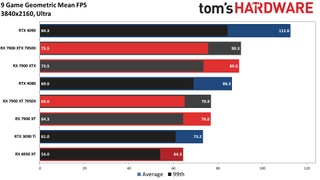
(Image credit: Tom’s Hardware)
Our CPU is AMD’s Ryzen 9 7950X3D, which offers faster gaming than any Intel CPU on the market, including the Core i9-14900K. It has a whopping 140MB of cache, thanks to AMDs innovative 3D V-Cache and it boasts 16 full-power cores and 32 threads, which is more regular cores than the 13900K’s set of 8 (to go with 16 E-Cores).
On our tests, the Ryzen 9 7950X3D beat Intel’s flagship, the 14900K by a full 21 fps on our 1440p suite of gaming tests. The cheaper, Ryzen 7 7800X3D is also really good at gaming, but does have as many cores for productivity.
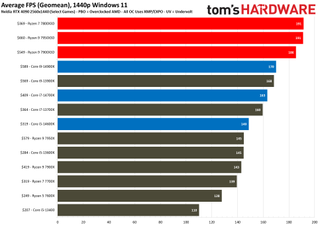
(Image credit: Tom’s Hardware)
We’re using an Asus ROG Strix X670E-E motherboard, which comes with built-in Wi-Fi 6E, four M.2 slots for storage and 18+2 power stages. To cool the Ryzen 9 7950X3D, we’re using a 360mm Lian-Li Galahad II Trinity 360mm AIO. When wereviewed the Galahad II , we found that it had the absolute best performance of any all-in-one cooler we’ve ever tested.
Because we’re fattening our budget for this build, we’re going with some speedy DRAM in the form of G.Skill’s Trident Z5 RGB DDR5 , which operates at up to 6,400 MHz. In ourreview of the G.Skill Trident Z5 , we lauded the kit’s strong performance and excellent overclockability. In our table, we are linking to a 32GB kit (2 x 16GB DIMMs as that is the highest capacity it is sold in. However, we recommend buying two of these kits so you can have 64GB of RAM.
We’re going with a 4TB Samsung 990 Pro, which has plenty of capacity and is the fastest PCIe 4.0 drive you can buy. Sure, we can go up to a PCIe 5.0 drive but we don’t see enough performance gains to justify one, even in this high end build right now.
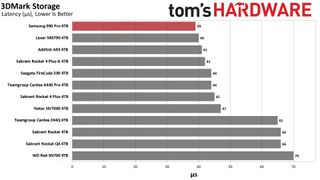
(Image credit: Tom’s Hardware)
We decided to go with a case that has a unique, premium look in theFractal Design North XL. With its wood paneled front, this chassis looks more like a mid-century modern piece of furniture than a gaming PC, which is a nice subtle touch. However, it also has a tempered glass side panel which you can use to show off all of your RGB components (or you can buy it with a solid panel and no window). It also has fantastic thermal performance and plenty of room for more drives and fans. The XL model can accommodate up to an E-ATX motherboard, giving you plenty of room for future upgrades.
With these high-end components, we don’t want to skimp on the power supply, and having something that’s fit for a future graphics card upgrade makes sense. We’re going with a full 1000-watts of power and the Corsair HX1000. This power supply is 80+ Platinum certified and fully modular.
Finding Discounts on the Best PC Components
To find savings on components of all types, check out our lists of thebest PC hardware deals , along with the latestNewegg promo codes ,Corsair coupon codes andBest Buy promo codes .
Also read:
- [New] 2024 Approved How to Undo a TikTok Refresh Blunder
- [New] 2024 Approved Understanding TikTok's Use and Interpretation of PFP
- [New] 2024 Approved Zipping Up an Enthralling TikTok Credit Sequence
- [New] Tips & Tricks for Joining Friends' LIVE on TikTok for 2024
- [New] Viral TikTok Essential Quotes for Engagement for 2024
- [Updated] 2024 Approved A New Era of Creativity Pinpointing the Best 10 Budget-Friendly Video Art Communities on YouTube
- [Updated] 2024 Approved Best Mac Slicer Software Enhance Video Production Prowess
- 2024 Approved A Comprehensive, Step-By-Step TikTok Editing Blueprint
- 2024 Approved The Pathway to Perfect Images Step-By-Step Backdrop Erasure
- Addressing Roblox Code 403 Blocks on PC
- Expert Tips for Enjoying High Dynamic Range in 4K Ultimate Visuals: A Complete How-To Manual
- How Do I Stop Someone From Tracking My Apple iPhone 15 Pro Max? | Dr.fone
- Tackling Shared Device with Two Users and One MS Error
- Top TikTok Patterns You Can’t Miss This Year for 2024
- Unlock Creative Potentials YouTube Trailers with Filmora
- Title: Riding on Innovation: Discover How Lenovo Is Boosting Its Legion #7000K Towers with Locally Developed Processor Technology in China
- Author: Brian
- Created at : 2025-02-14 10:26:38
- Updated at : 2025-02-20 02:12:09
- Link: https://tiktok-videos.techidaily.com/riding-on-innovation-discover-how-lenovo-is-boosting-its-legion-7000k-towers-with-locally-developed-processor-technology-in-china/
- License: This work is licensed under CC BY-NC-SA 4.0.